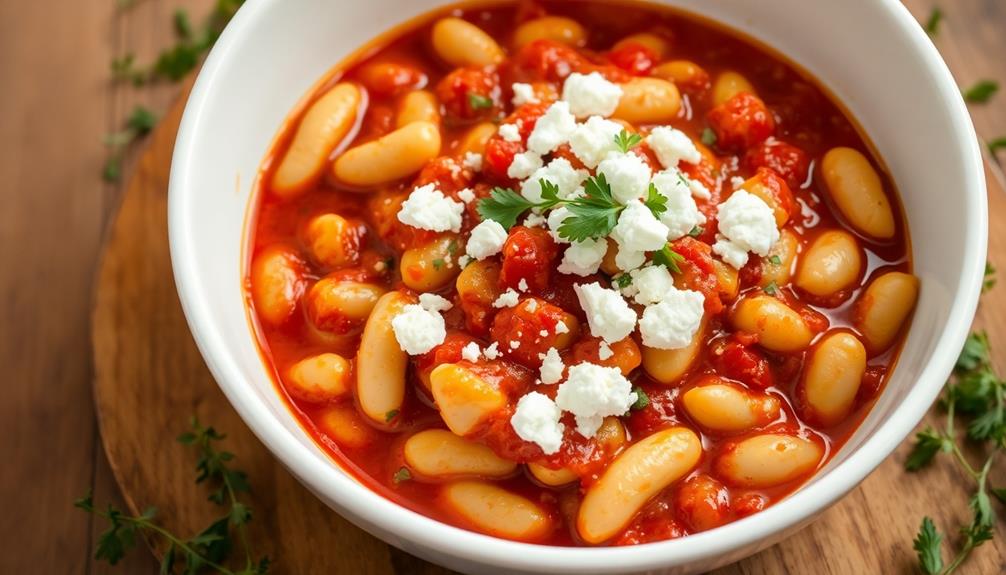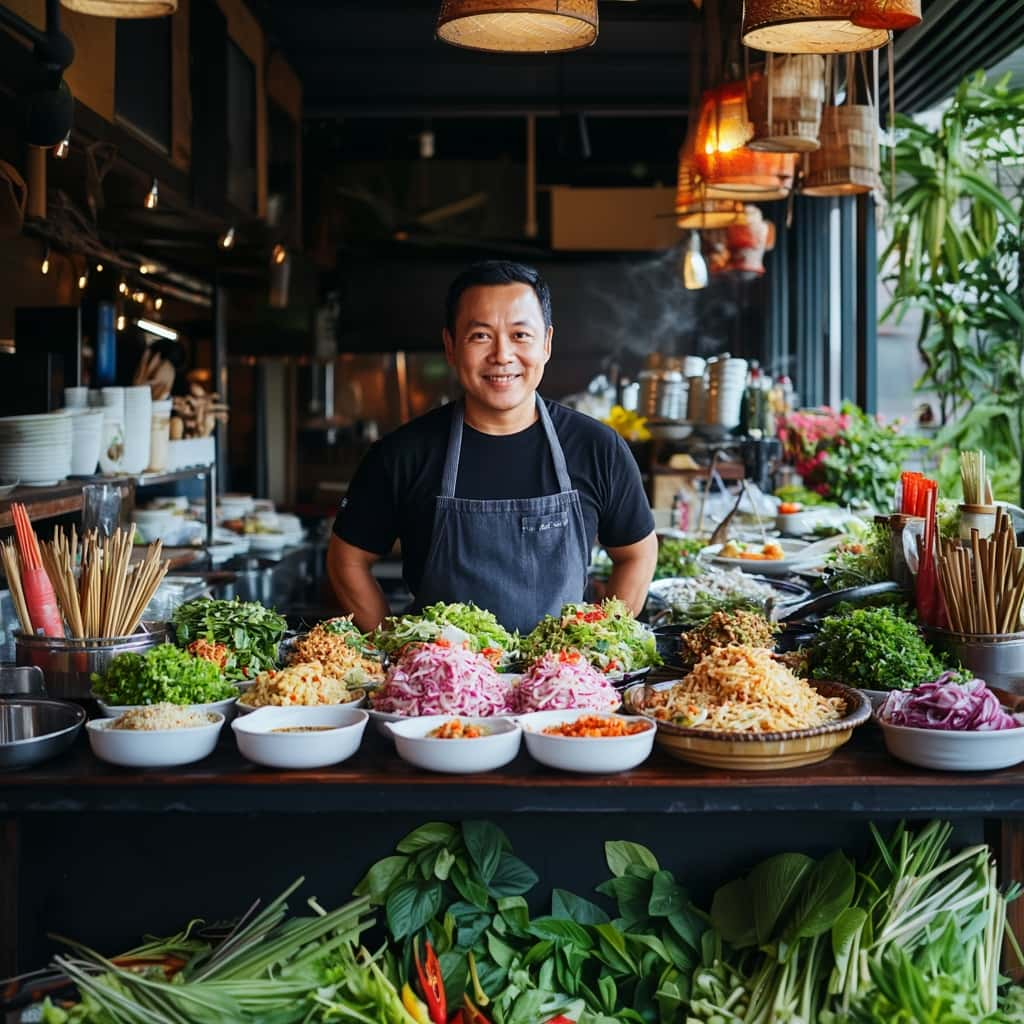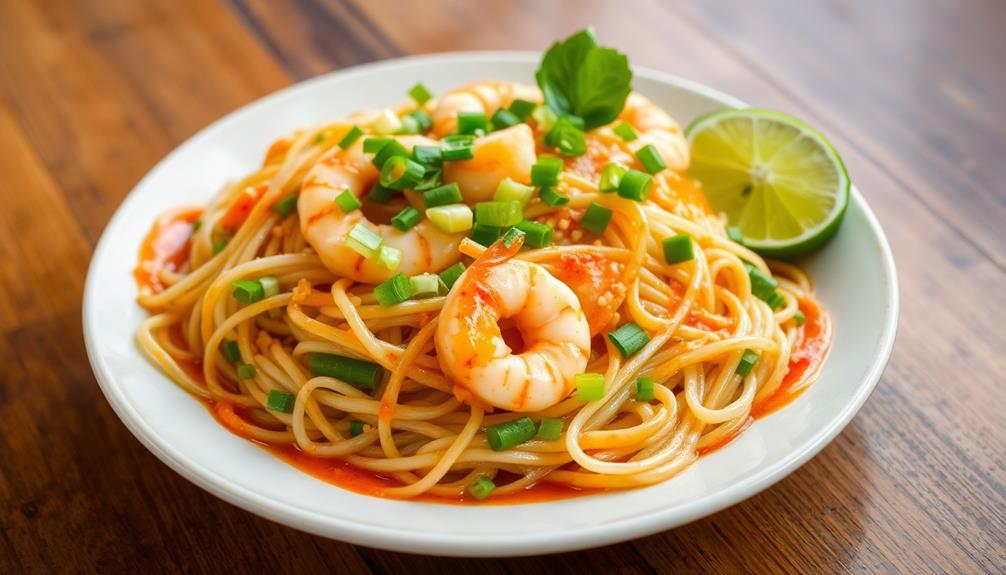Kuay Tiew Kua Gai, or stir-fried chicken noodles, is a beloved Thai street food dish that's evolved over centuries, drawing influence from Chinese immigrants. You'll find its bold, vibrant flavors in night markets, neighborhood eateries, and high-end restaurants across Thailand. The key to success lies in ingredient preparation and stir-frying technique – tender chicken, crisp veggies, and a flavorful sauce come together in this staple Thai dish. Fresh, high-quality components and quick, high-heat cooking are crucial. Wondering how to make this satisfying meal at home? Read on to discover the details that make Kuay Tiew Kua Gai so delicious.
Key Takeaways
- Kuay Tiew Kua Gai is a beloved Thai stir-fried chicken noodle dish with a history of Chinese influence and street food origins.
- The dish features tender chicken, crisp vegetables, and a flavorful sauce, offering a balanced and satisfying meal.
- Proper ingredient preparation, including marinating the chicken and using fresh herbs, is crucial for achieving authentic flavor.
- High-heat stir-frying technique is essential to preserve the dish's essence and develop the desired textures and flavors.
- The harmonious balance of flavors, such as the acidity from lime and the freshness of herbs, enhances the overall culinary experience.
History
Originating from the vibrant street food culture of Thailand, Kuay Tiew Kua Gai has long been a beloved dish among locals and travelers alike. Its roots can be traced back to the Chinese immigrants who settled in Thailand centuries ago, blending their culinary traditions with local flavors.
Over time, this stir-fried chicken noodle dish evolved, becoming a staple of the country's diverse and flavorful cuisine.
Today, Kuay Tiew Kua Gai can be found in bustling night markets, cozy neighborhood eateries, and even high-end restaurants across Thailand. Each chef puts their own unique spin on the recipe, creating a symphony of textures and tastes that keep diners coming back for more.
Whether you prefer your noodles firm or soft, your chicken juicy or crispy, there's a version of Kuay Tiew Kua Gai to satisfy every palate. It's a dish that truly captures the essence of Thai culinary creativity and the country's love for bold, vibrant flavors.
Recipe
Kuay Tiew Kua Gai is a delightful Thai stir-fried rice noodle dish that features tender chicken, crisp vegetables, and a flavorful sauce. This dish is a staple in Thai street food and home kitchens alike, offering a satisfying and balanced meal. For an authentic Thai chicken rice recipe, Kuay Tiew Kua Gai is a must-try. The dish is typically seasoned with a blend of soy sauce, oyster sauce, and sugar, giving it a savory and slightly sweet flavor profile. Whether enjoyed on its own or paired with other Thai dishes, Kuay Tiew Kua Gai is a beloved and comforting choice for any meal.
The key to a successful Kuay Tiew Kua Gai lies in the preparation of the ingredients and the technique of stir-frying. By carefully selecting fresh and high-quality components, and mastering the art of quick, high-heat cooking, you can create a dish that tantalizes the senses and delights the palate.
Ingredients:
- 8 oz rice noodles
- 1 lb boneless, skinless chicken thighs, cut into bite-sized pieces
- 2 cloves garlic, minced
- 1 onion, sliced
- 1 red bell pepper, sliced
- 2 cups bean sprouts
- 2 eggs, lightly beaten
- 2 tbsp fish sauce
- 1 tbsp soy sauce
- 1 tbsp brown sugar
- 1 tsp ground white pepper
- 2 tbsp vegetable oil
Cooking Instructions:
In a large wok or skillet, heat the vegetable oil over high heat. Add the garlic and stir-fry until fragrant, about 30 seconds.
Add the chicken and cook, stirring frequently, until the chicken is cooked through and lightly browned, approximately 5-7 minutes.
Add the onion and bell pepper, and continue to stir-fry for an additional 2-3 minutes, until the vegetables are tender-crisp.
Push the chicken and vegetables to the side of the wok, and pour the beaten eggs into the center. Allow the eggs to cook for 1-2 minutes, then scramble and incorporate them into the other ingredients.
Add the rice noodles, fish sauce, soy sauce, brown sugar, and white pepper. Toss everything together, continuously stirring and mixing, until the noodles are evenly coated and heated through, about 2-3 minutes.
To ensure the best results when cooking Kuay Tiew Kua Gai, it's important to have all the ingredients prepped and ready to go before you begin stir-frying.
This will allow you to work quickly and efficiently, preserving the texture and flavors of the dish. Additionally, be sure to use a hot, well-seasoned wok or skillet to achieve the desired sear and caramelization on the ingredients.
Cooking Steps
First, prepare the chicken by marinating it in a blend of flavorful ingredients.
Next, stir-fry the aromatic veggies in hot oil until fragrant.
Then, add the rice noodles and chicken to the pan, tossing everything together until the noodles are cooked through.
Step 1. Prepare and Marinate Chicken
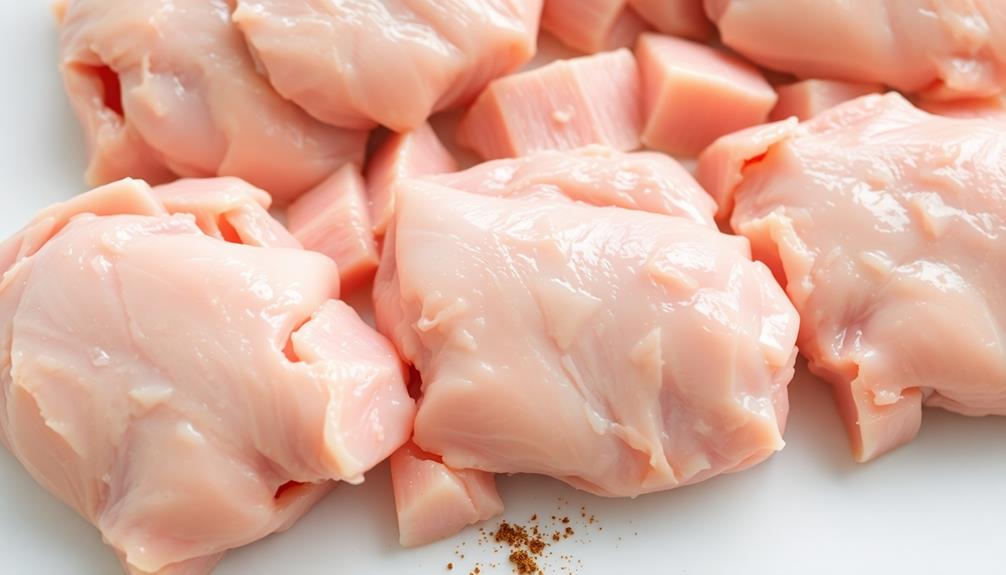
Preparing the chicken is the next crucial step in crafting the perfect Kuay Tiew Kua Gai. First, you'll need to give the chicken a thorough rinse and pat it dry with paper towels.
Next, cut the chicken into bite-sized pieces, about 1-inch cubes. This will help the chicken cook evenly and absorb the flavors of the marinade.
In a large bowl, combine the chicken, soy sauce, fish sauce, garlic, white pepper, and a pinch of sugar. Gently mix everything together until the chicken is evenly coated.
Cover the bowl and let the chicken marinate in the refrigerator for at least 30 minutes, or up to 2 hours. This step allows the flavors to meld and tenderizes the chicken, ensuring a delicious and juicy result.
Once the chicken has marinated, you're ready to move on to the next step of the cooking process. Get your wok or large skillet ready for some stir-frying action!
Step 2. Stir-Fry Aromatics in Oil
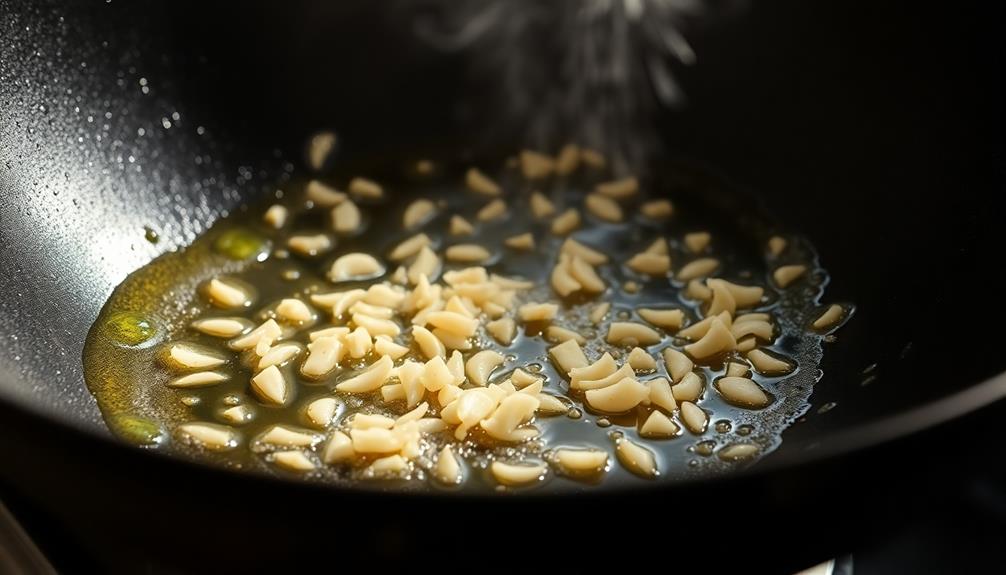
Heat a large wok or skillet over high heat.
Once it's nice and hot, add a few tablespoons of oil. Toss in the chopped garlic, shallots, and chilies. Stir-fry these aromatic ingredients for about a minute, until they're fragrant and starting to sizzle.
Be careful not to let the garlic burn – it can easily turn bitter.
Next, add the sliced chicken to the wok. Stir-fry the chicken for 2-3 minutes, making sure to break up any clumps, until it's mostly cooked through. The chicken should be lightly browned on the edges.
Now it's time to add the fish sauce, soy sauce, and a splash of water or chicken broth.
Give everything a good stir to combine the flavors. Let the sauce simmer for a minute or two, allowing it to thicken slightly. This step infuses the chicken with those incredible Thai flavors.
Step 3. Add Rice Noodles and Chicken
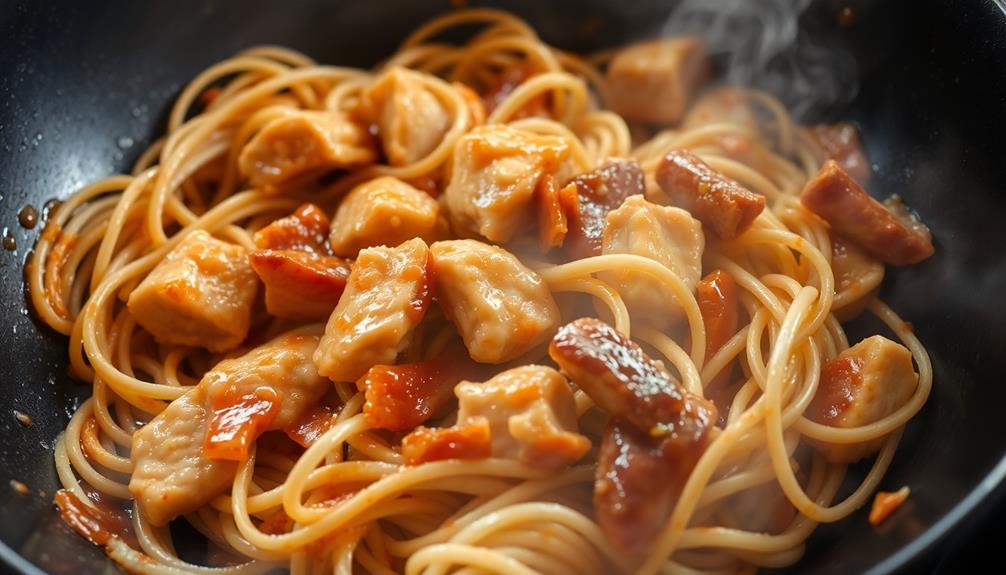
Once the chicken is cooked, you'll want to add the rice noodles. They'll need to soak in the hot cooking liquid for a few minutes to soften and absorb all the delicious flavors.
Gently stir the noodles, ensuring they don't stick together. As they become tender, you can add a splash of soy sauce and a squeeze of fresh lime juice. This will enhance the overall taste and bring a bright, tangy note to balance the richness of the dish.
Next, you'll toss in the cooked chicken. Gently combine everything, allowing the noodles to soak up the savory chicken juices. If the mixture seems dry, you can add a bit more cooking liquid or a splash of chicken broth. The goal is to have a harmonious blend of noodles, chicken, and flavorful sauce.
Once everything is heated through and well-integrated, your Kuay Tiew Kua Gai is ready to serve. Garnish with fresh cilantro, sliced green onions, and a sprinkle of crushed peanuts for a satisfying and authentic Thai-inspired dish.
Step 4. Toss Noodles and Chicken Together
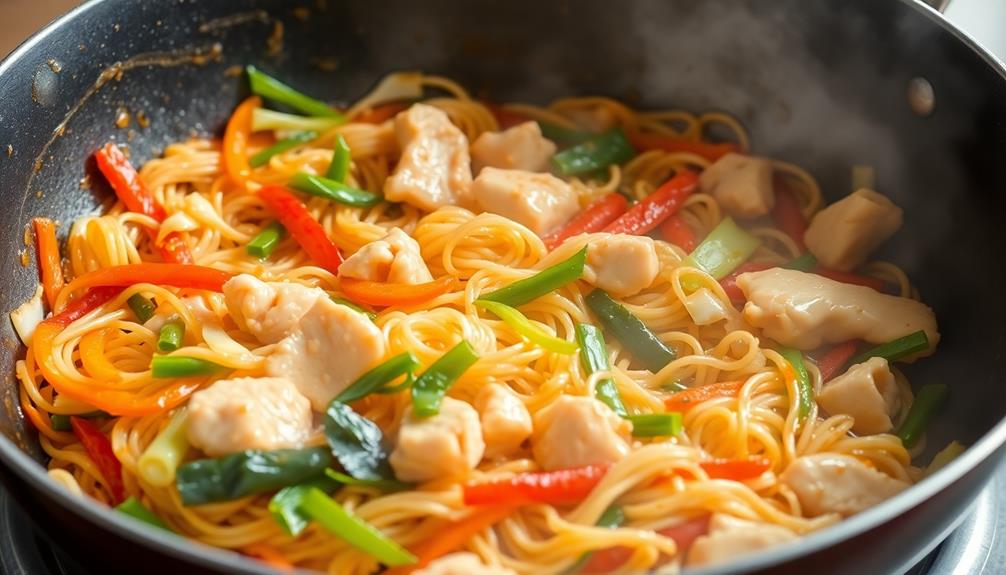
With the rice noodles softened and the chicken fully cooked, you'll toss everything together in the pan.
Using tongs or chopsticks, gently mix the noodles and chicken, making sure to coat the noodles evenly with the flavorful sauce. You'll want to toss the mixture for 1-2 minutes, just until the noodles are hot and everything is well combined.
As you toss, you may need to add a splash of water or chicken broth to the pan to keep the noodles from sticking. The goal is to create a nice, saucy consistency that coats the noodles and chicken.
Be careful not to overmix, as you don't want to break up the noodles.
Once everything is tossed together, you can transfer the Kuay Tiew Kua Gai to a serving plate or bowl.
Garnish with the crispy fried shallots, chopped cilantro, and a squirt of lime juice for a bright, fresh finish.
Step 5. Garnish With Fresh Herbs
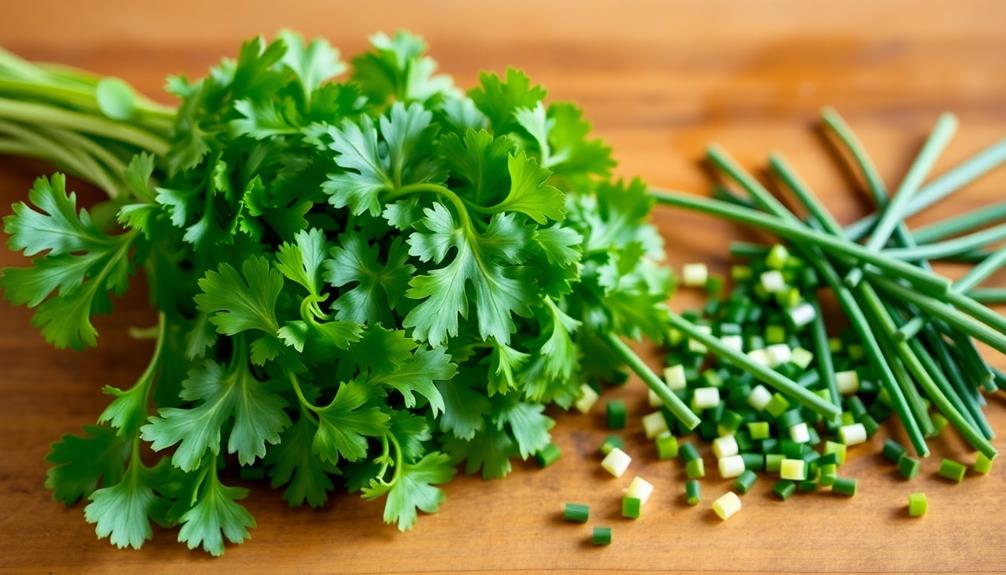
Garnished with the aromatic cilantro and a final squeeze of tangy lime, the Kuay Tiew Kua Gai comes alive with a burst of fresh flavor. The cilantro's vibrant green leaves and delicate aroma add a delightful contrast to the savory noodles and chicken.
Be sure to use the tender, leafy parts, avoiding the thicker stems. Sprinkle the cilantro generously over the stir-fried mixture, allowing its flavors to mingle with the other ingredients.
Next, slice a fresh lime in half and give the dish a final squeeze just before serving. The tart, citrusy notes of the lime juice brighten the entire dish, cutting through any richness and heightening the overall flavor profile.
Encourage your guests to add a little extra lime juice to their individual servings, as the acidity can vary based on personal taste preferences.
Together, the cilantro and lime create a harmonious balance, elevating the Kuay Tiew Kua Gai and ensuring each bite is bursting with freshness.
Final Thoughts
As you approach the final steps of preparing this beloved Thai dish, Kuay Tiew Kua Gai, take a moment to reflect on the journey.
You've carefully selected the freshest ingredients, mastered the art of stir-frying, and layered the flavors to perfection. Now, it's time to bring it all together with a flourish.
Garnish your steaming plate of Kuay Tiew Kua Gai with the vibrant colors and crisp textures of fresh herbs. The fragrant cilantro and the bright, peppery taste of Thai basil will elevate the dish, creating a symphony of flavors and aromas.
Don't forget to squeeze a wedge of lime over the top, adding a final burst of acidity to balance the richness of the chicken and noodles.
As you dig in, savor each bite, taking note of the tender chicken, the slippery noodles, and the harmonious blend of seasonings.
This dish is a true testament to the depth and complexity of Thai cuisine. Enjoy the fruits of your labor, and don't be surprised if friends and family request this delightful Kuay Tiew Kua Gai again and again.
Frequently Asked Questions
What Kind of Chicken Is Best for This Dish?
You'll want to use boneless, skinless chicken thighs for this dish. The dark meat stays juicier and more flavorful than chicken breasts when stir-fried. Avoid whole chicken pieces, as they'll take longer to cook through.
Can I Substitute the Rice Noodles With Other Types?
You can certainly substitute the rice noodles with other types, like egg noodles or even wheat-based noodles. Just adjust the cooking time and technique accordingly to ensure the dish turns out perfectly.
How Do I Ensure the Noodles Don't Stick Together?
To prevent noodles from sticking together, start by boiling them in plenty of water until just tender. Drain and rinse under cold water, then toss with a bit of oil. This helps keep the noodles separate.
Is It Possible to Make This Dish Vegetarian?
Absolutely! You can make this dish vegetarian by substituting the chicken with firm tofu or mushrooms. Just adjust the cooking time and seasonings to suit the new protein. The key is to ensure the noodles and veggies are cooked evenly.
How Can I Adjust the Spiciness Level to My Preference?
To adjust the spiciness level to your preference, start by adding less chili peppers or chili paste to the dish. You can gradually increase the amount until you reach your desired level of heat. Consider using milder spices as well.

